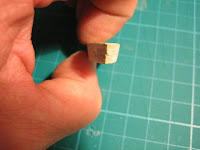
I have three Xyston merchant ships and not knowing anything about these vessels I decided that I should use their model as a pattern. The tools and materials I needed were ready at hand so I began; they were:
Milliput
Wire
Steel rule (for flattening)
Glass 'table-top', cutting board and some odds and ends of perspex for modelling on.
Scalpel with 10A blades.
Sand paper and various needle files
Thin card
Superglue
Angle lamp (for light, but more importantly to 'quick-dry' the model at its various stages of completion).




First I flattened a piece of Milliput about 3mm thick and then lightly imprinted the bottom of the Xyston model into it (this was the one and only physical use of the Xyston model) and cut out the shape of the lower hull. When this had set I flattened out another piece of Milliput, and using the lower hull as a template, cut out the shape of the upper hull. This was slightly larger than the lower hull. When set I filed and sanded the whole thing down until I was happy with the overall shape.


Because I will be using a RTV silicon rubber mould (not vulcanising) the choice of materials I could use in the vessels construction was quite wide - they just have to be to non porous. So to make the detail on the hull (in the form of bands) I used thin card (in this case red) soaked in superglue. These were applied with superglue.

The prow of the ship extends some distance so I drilled the hull and added a thin piece of piano wire for strength. I then built up the prow a little and the upward curve of the hull at the bow.






Because I will be using a RTV silicon rubber mould (not vulcanising) the choice of materials I could use in the vessels construction was quite wide - they just have to be to non porous. So to make the detail on the hull (in the form of bands) I used thin card (in this case red) soaked in superglue. These were applied with superglue.

The prow of the ship extends some distance so I drilled the hull and added a thin piece of piano wire for strength. I then built up the prow a little and the upward curve of the hull at the bow.




To give the hull a little more outward curve I added a card deck (again soaked in superglue) slightly wider than the milliput hull and back filled the underside. This is a much easier method than trying to shape the hull with milliput alone. Once this job was done I finished the basic hull shape with more sculpting and filing.


Next I made the canvas covered structure at the stern of the ship and a roughly shaped stern post. Once set I did a little more shaping to the stern-post with milliput and file then stuck it to the hull. A little more work was required to match the stern-post to the hull but this only involved a little bit of filling. Xyston ships come with separate rudders, but these a very thin and might not be easy to cast using a drop mould. Consequently, I decided to add mine to the model to be cast in position. Each rudder oar was made from flattened piece of milliput (cut to oar shape) and a piece of wire glued to the model, back filled to the hull for casting purposes, and filed; a little ball of milliput at the top of the oar finished the job


Next I made the canvas covered structure at the stern of the ship and a roughly shaped stern post. Once set I did a little more shaping to the stern-post with milliput and file then stuck it to the hull. A little more work was required to match the stern-post to the hull but this only involved a little bit of filling. Xyston ships come with separate rudders, but these a very thin and might not be easy to cast using a drop mould. Consequently, I decided to add mine to the model to be cast in position. Each rudder oar was made from flattened piece of milliput (cut to oar shape) and a piece of wire glued to the model, back filled to the hull for casting purposes, and filed; a little ball of milliput at the top of the oar finished the job
So there it was - not bad for 4 hours work (give or take). I have posted a picture of Xyston's model and my own. Mine does not have the fine finish of the Xyston model, but it will pass muster. At the end of the day, they are only non-combatant merchantmen.


My next modelling post will be on making moulds using RTV silicon with a plaster sabot.




4 comments:
You have far more talent than I in being able to do this.
Great work - you really ought to try more.
I'm trying as hard as I can
James
I like yours better!
Post a Comment